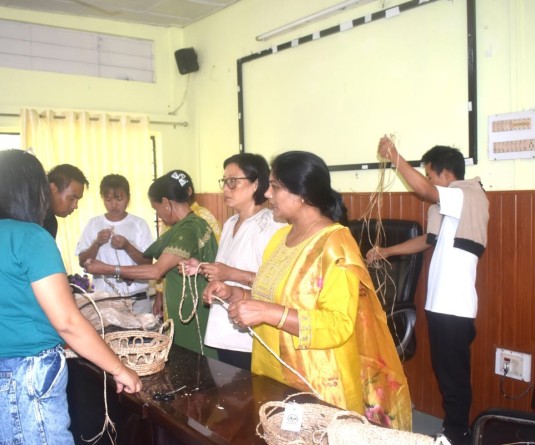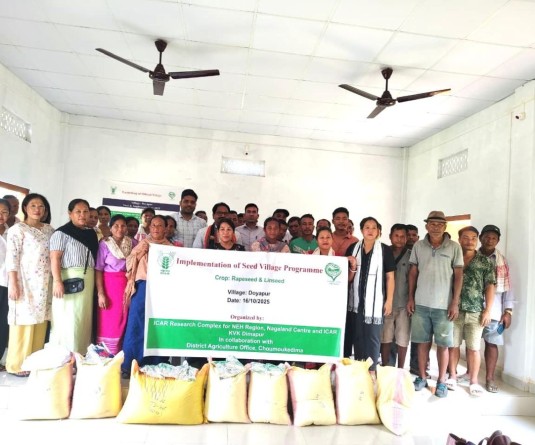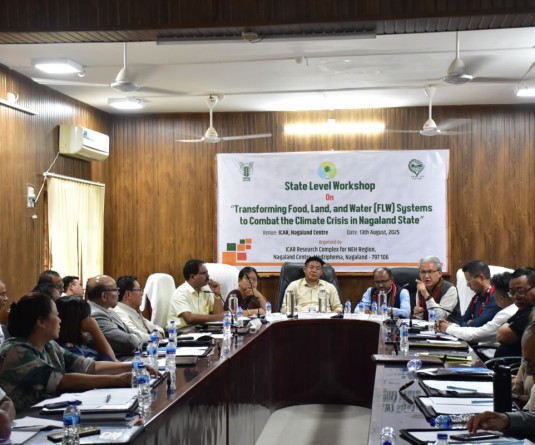
Areca nut is a plantation crop and its fruit is categorized as a berry and is popular by the name supari or betel nut. It is commercially available in dried, cured, and fresh forms. It is one of the important commercial crop in South East Asia. Areca nut has the never ending list of uses i.e. for chewing purpose, as medicine, as vegetable, as stimulant, fuel wood, lubricant, tannin, wrapping, clothing etc., Medicinal properties of areca nut which are helpful for diseases such as dysentery, diarrhea, heart burn, urinary stones, etc., are also reported.
India is major producer and consumer of Areca nut in the world as per FAO statistics for 2017, accounting for 54.07 % of its world output, and is exported to many countries. In Nagaland it is grown in an area of 180.11 hectare with a production of 1113.60 MT. (Source: Statistical hand book of Nagaland, 2018)
Areca nut cultivation faces numerous hurdles like vagaries of weather coupled with climatic change, quality cultivars, mostly confined to small holdings and also the diseases which sometimes cause upto 60 per cent looses.
Major diseases of Areca nut and their management
1. Fruit rot or Koleroga or Mahali (Phytophthara meadii)
Symptoms: Rotting and heavy shedding of nuts are the characteristic symptoms during rainy season. Dark green water-soaked lesions noticed near perianth end and spread gradually covering the entire surface of fruit and finally shed off. In advanced stages, whitish mycelia growth is seen over the nut surface. Infected nuts showed discoloration of kernel, reduction in weight and large vacuole. At the end of monsoon the fruits dry up and remains mummified without shedding.
2. Bud rot and Crown rot (Phytophthora meadii)
Symptoms: Bud rot is characterized by initial yellowing of spindle leaf, rotting of growing bud which can be drawn out easily with a gentle pull, followed by infection in surrounding leaves. As the disease advances, adjacent leaves also starts yellowing, droops and finally fall off completely by leaving the bare stem.
Crown rot is typically renowned by the green drooping leaves followed by yellowing of leaf sheaths and leaves of the outermost whorl by leaving the spindle leaf healthy. Inner portion of the affected leaf sheath shows clear water-soaked lesions. The spear leaf remains green till the bud portion is fully damaged. In advanced stages, all the leaves become yellow, droop, dry up and remain attached to the stem. Inner stem tissue becomes discoloured. The infected palms are killed and the top portion of the stem gets cut off at the point of infection.
Management: Field sanitation practices like collection and destruction of the infected nuts, dried bunches, shed nuts and the crowns of the palms affected by bud/ crown rots may help to reduce the year round survival of the pathogen inoculum. In case of fruit rot, covering the bunch with polythene before the onset of monsoon also gives complete control. Spray Bordeaux mixture (1 %) to the bunches at least two times at an interval of 45 days. The first spray should be given immediately after the first few monsoon showers. If the monsoon prolongs, a third spray is required. Use adhesive or sticker to ensure tenacity of the spray deposit on treated substrate. Also smearing with 10 per cent Bordeaux paste after removal of affected tissues is effective in saving bud rot affected palms. Crown rot can also be managed by drenching the rhizosphere region with potassium phosphonate/ salt of phosphorous acid. Monitoring of treated palms is needed for checking further advancement of symptoms.
3. Inflorescence die-back (Colletotrichum gloeosporioides)
Symptoms: Yellowing starts from the tip of the rachillae towards the main rachis and spreads downwards. Later, it turns dark brown followed by drying; a condition called as die-back. Subsequent spread of yellowing and discoloration induces shedding of female flowers. It becomes severe in the month of February-May though it occurs throughout the year.
Leaf spot (Colletotrichum gloeoesporioides; Phyllosticta)
Symptoms: The disease appears during South West monsoon season. Plants up to 10 years are more susceptible. Small brown to dark brown or black round spots are seen on the lamina. Severe infection causes stunted growth in seedlings.
Management: Field sanitation practices include removal and burning of diseased leaves, infected dried bunches and fully affected inflorescences to reduce the inoculum level. Spraying of Bordeaux mixture (1 %) or Dithane M-45 (3g /litre of water) while opening of female flowers will reduces the disease incidence. A second spraying should be taken up after 20-25 days.
4. Anaberoga or foot rot or basal stem rot (Ganoderma lucidum)
Symptoms: Initially there is yellowing of outer whorl of leaves gradually extending to inner whorls. As the disease progresses, the entire crown becomes yellow leaving only the spear leaf green. In the advanced stages, spindle also gets dried up and finally the crown drop off leaving the base stem. At the basal portion of the stem, small dull brown spots occurs which later coalesce to bigger patches at 1 m height of the trunk from ground level. At acute stage, brown gummy liquid oozes out and bracket shaped fruiting bodies formed at the base of the trunk after death of palms. Rotting of roots and internal tissues of the basal portion of the stem occurs and it is difficult to identify the disease in the early stages of infection.
Management: Proper management of the garden is the best way to check the occurrence of the disease. Drenching the rhizosphere with propiconazole (1 ml/L) @ 15-20L/palm along with root feeding of propiconazole (1 ml/L) @ 125 ml/palm at quarterly intervals will help in disease management. Apply 2kg neem cake per palm per year. Phytosanitary measures like cutting and burning of the dead palms along with bole and roots should be followed strictly. Isolate the diseased palms by digging trenches of 30cm wide and 60cm deep around the palm. Improvement of drainage and spraying of Borax @2g/l in the initial stages of disease are found effective in controlling the disease.
5. Yellow leaf disease (YLD) (Candidatus Phytoplasma)
Symptoms: YLD is caused by Phytoplasma and transmitted by the vector, Proutista moesta. Yellowing of the leaves is the typical symptom of YLD. Yellowing starts from the tip of the leaflets of the outer leaves and sometimes seen in the middle whorl and spreads gradually extending from the margin to the middle of lamina portions near the midrib remain green. In advanced stages, yellowing spreads to all leaves completely, dry and fall off. Kernel of the nuts of affected palms become soft show blackish discolouration and assumes a spongy texture.
Management: Removal of all the diseased palms and replanting with disease free seedlings is effective in mildly affected areas and removal of the severely affected palms with poor yield should be carried out in heavily affected areas. Balanced nutrient management (NPK @ 100:40:140 g/palm/year), organic manure application @ 12 kg/palm/year and an additional dose of super phosphate (1 kg/ palm) along with provision of summer irrigation can improve the condition of the palms. Proper drainage facilities should be provided to avoid water stagnation. Remove the diseased palms in the mildly affected areas to prevent the spread of the disease.
If the diseases are identified at an early stage and management practices are taken up, the yield looses will be reduced to a great extend.
(Article contributed by E Lireni Kikon SMS, Plant Protection and Dr Ebibeni Ngullie i/c Head ICAR-KVK Dimapur, Nagaland)






